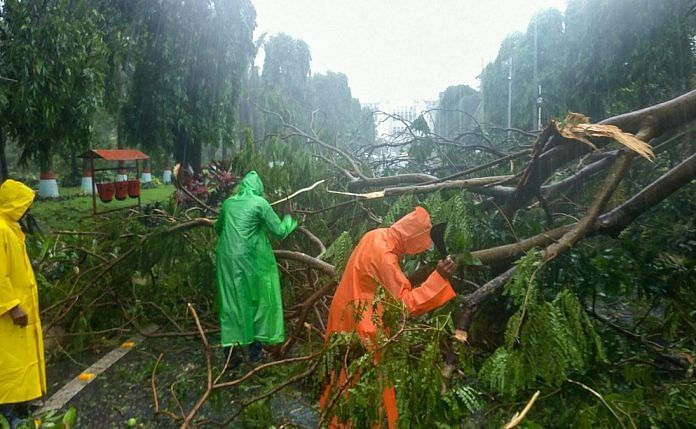New Delhi: The 15th finance commission is exploring ways to change the way post-disaster management is financed, in a bid to ensure sufficient funds are kept aside for rehabilitation, mitigation and capacity-building rather than being allocated for just immediate relief.
This may come as good news for states such as Odisha and Kerala, battling problems of adequate funding for rehabilitation after a disaster. While Kerala is recovering from massive floods that hit the state last year, Odisha is battling the aftermath of Cyclone Fani, which made landfall last week causing massive destruction to the state’s infrastructure.
The current mechanism of using the National Disaster Response Fund (NDRF) and the State Disaster Response Fund (SDRF) mainly focuses on immediate relief and is based on fixed allocations without taking into account how vulnerable a state is to natural disasters.
SDRF had a total allocation of Rs 61,220 crore for the five-year period 2015-20, with Maharashtra receiving the largest share followed by Rajasthan and Madhya Pradesh — a reflection of the unequal distribution among states.
The terms of reference of the 15th finance commission included reviewing the ‘present arrangements on financing disaster management initiatives, with reference to the funds constituted under the Disaster Management Act, 2005’. This could see a more effective way of allocation of funds to states to tackle disasters.
Also read: PM Modi surveys Odisha’s Cyclone Fani-hit areas, announces Rs 1,000-cr additional relief
What is in the works
N.K. Singh, chairman of the 15th finance commission, said a workshop jointly organised with the World Bank and United Nations Development Programme (UNDP) on disaster financing management has resulted in many such recommendations.
“Based on the recommendations and the international best practices, we will be taking a holistic look at disaster management financing,” Singh told ThePrint. “It will not only be about recovery and rehabilitation but also about mitigation and capacity-building,” he said.
“Mitigation and capacity-building were an integral part of the disaster management act of 2005 but no provision was set aside for it,” added Singh. “We will be looking at the entire gamut of disaster management financing consistent with the disaster management act of 2005 and international best practices.”
Krishna Vatsa, a recovery advisor with UNDP, wrote in a note posted on the UNDP website in April that the programme has recommended to the finance commission that the fund allocation should take into account the existing state expenditures on disaster management, its area and population as well as the risk levels faced by each state reflected by a risk index that accounted for vulnerability and hazard for four disasters — earthquakes, floods, droughts and cyclones.
“The total allocation that we propose for all the states is approximately US $16 billion over the next five years. We recommend four funding windows for the total state allocations — one, response and relief (40 per cent); two, recovery and reconstruction (30 per cent); three, mitigation (20 per cent); and four, preparedness and capacity-building (10 per cent),” he wrote, adding that the final criteria recommended by UNDP combines the existing methodology of state expenditures and the state’s area and population, assigning a weightage of 70 to expenditures and 30 to area and population, divided equally and assigning a state risk score.
“It was an intensive exercise in allocating state resources where we innovated at two levels: First, developing a risk-informed criterion for allocation; and second, diversifying the funding windows for disaster risk management,” he has added.
Vatsa could not be reached for comments.
Also read: Environment is the most under-reported disaster of Narendra Modi government
Problem of inadequate funding for Indian states
Indian states have been vocal in their demand for an expenditure mechanism that takes care of the entire disaster management, including recovery and rehabilitation rather than just immediate relief.
“The NDRF provides funds for immediate relief,” a Kerala state government official, who did not wish to be identified, said. “This may also involve road repairs and housing construction besides search and rescue operations, temporary relief by the provision of water and food and monetary relief to the dead and injured.”
The official, however, added that guidelines governing the fund usage are pretty strict restricting them from being used for other purposes.
“For instance, the allocation is as little as Rs 1 lakh for a km of road, whereas the actual cost is around Rs 1 crore per km. Similarly, a fully damaged house is provided Rs 95,100, which is far from adequate. It is not enough for reconstruction at a scale required for a natural disaster,” the official said.
“Another problem is that a fixed amount is allocated to each state from the NDRF. Only a small part of the funds is kept aside for providing relief to states hit by a natural disaster,” the official said.
In his note, Vatsa pointed out that the existing methodology allocates resources based on states’ expenditures on disasters.
“The more states spend, the more money they receive. That means relatively better off and well-administered states that can spend more are favoured,” he wrote. “The methodology does not account for the risk and vulnerability profile of a state, leading to a huge asymmetry in state-level allocations.”




This post misrepresents UNDP’s methodology and the basis for their recommendations for budget allocation. Assigning budget allocations on the basis of the 70/30 expenditure/area and population calculation would largely replicate the existing problem of giving states more money because they spend more money. Ascertaining budget in this way would incentivize inefficient spending. Please provide links in your articles so that readers can read for themselves what was said.
http://www.in.undp.org/content/india/en/home/blog/equipping-states-for-disaster.html